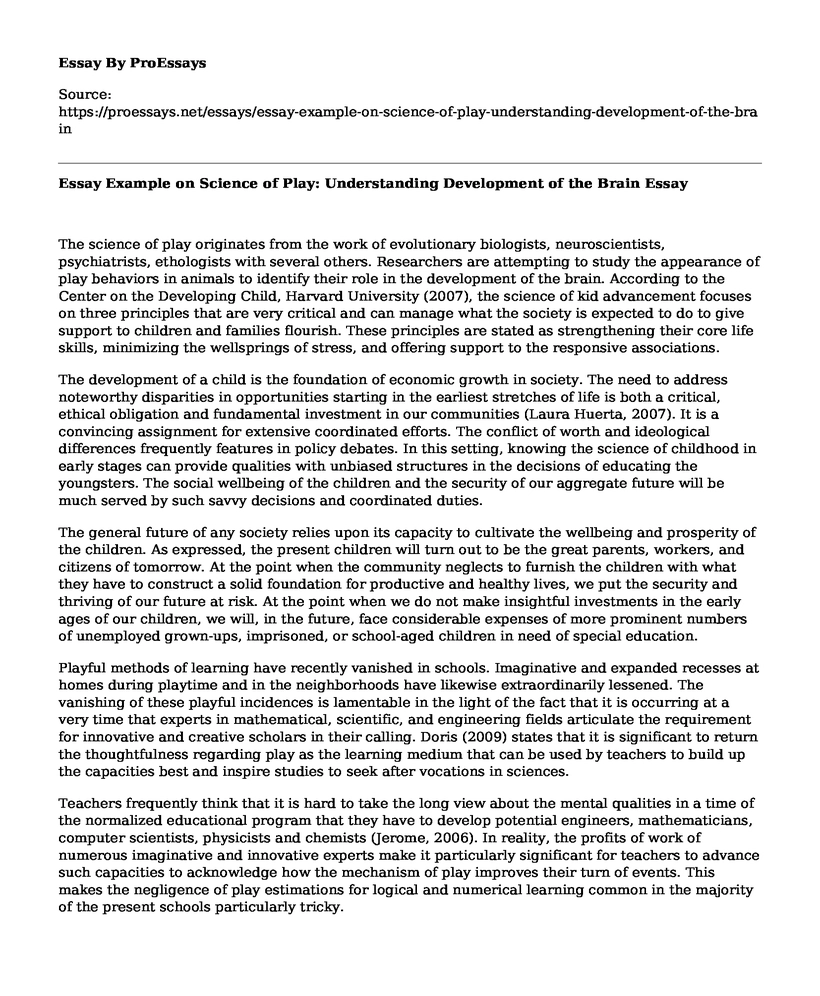The science of play originates from the work of evolutionary biologists, neuroscientists, psychiatrists, ethologists with several others. Researchers are attempting to study the appearance of play behaviors in animals to identify their role in the development of the brain. According to the Center on the Developing Child, Harvard University (2007), the science of kid advancement focuses on three principles that are very critical and can manage what the society is expected to do to give support to children and families flourish. These principles are stated as strengthening their core life skills, minimizing the wellsprings of stress, and offering support to the responsive associations.
The development of a child is the foundation of economic growth in society. The need to address noteworthy disparities in opportunities starting in the earliest stretches of life is both a critical, ethical obligation and fundamental investment in our communities (Laura Huerta, 2007). It is a convincing assignment for extensive coordinated efforts. The conflict of worth and ideological differences frequently features in policy debates. In this setting, knowing the science of childhood in early stages can provide qualities with unbiased structures in the decisions of educating the youngsters. The social wellbeing of the children and the security of our aggregate future will be much served by such savvy decisions and coordinated duties.
The general future of any society relies upon its capacity to cultivate the wellbeing and prosperity of the children. As expressed, the present children will turn out to be the great parents, workers, and citizens of tomorrow. At the point when the community neglects to furnish the children with what they have to construct a solid foundation for productive and healthy lives, we put the security and thriving of our future at risk. At the point when we do not make insightful investments in the early ages of our children, we will, in the future, face considerable expenses of more prominent numbers of unemployed grown-ups, imprisoned, or school-aged children in need of special education.
Playful methods of learning have recently vanished in schools. Imaginative and expanded recesses at homes during playtime and in the neighborhoods have likewise extraordinarily lessened. The vanishing of these playful incidences is lamentable in the light of the fact that it is occurring at a very time that experts in mathematical, scientific, and engineering fields articulate the requirement for innovative and creative scholars in their calling. Doris (2009) states that it is significant to return the thoughtfulness regarding play as the learning medium that can be used by teachers to build up the capacities best and inspire studies to seek after vocations in sciences.
Teachers frequently think that it is hard to take the long view about the mental qualities in a time of the normalized educational program that they have to develop potential engineers, mathematicians, computer scientists, physicists and chemists (Jerome, 2006). In reality, the profits of work of numerous imaginative and innovative experts make it particularly significant for teachers to advance such capacities to acknowledge how the mechanism of play improves their turn of events. This makes the negligence of play estimations for logical and numerical learning common in the majority of the present schools particularly tricky.
Conclusion
In conclusion, researchers argue that play is an internal state and must be enjoyable to provide an element of fun. On the off chance that we perceive the significance of play as a medium of learning and comprehend that playful is a quality esteemed by all ages, at that point, we may get prominent with more estimations of fun-loving learning in schools. Consequently, enhancing playful learning at all phases of education will produce warranted professionals in all fields since active learning could turn into the influx of things to come.
References
Jerome (2006). Creativity and play: a systematic approach to managing innovation. Business journal. Volume 2, p20-64. doi: 10.4102/sajbm.v36i4.643
Doris Bergen (2006). Play as the learning medium for scientists, mathematicians, and engineers-American journal of play. https://www.journalofplay.org/sites/www.journalofplay.org/files/pdf-articles/1-4-article-play-as-learning-medium.pdf
Laura Huerta (2007). The science of early childhood development. Harvard University. https://www.developingchild.net
Cite this page
Essay Example on Science of Play: Understanding Development of the Brain. (2023, Jul 12). Retrieved from https://proessays.net/essays/essay-example-on-science-of-play-understanding-development-of-the-brain
If you are the original author of this essay and no longer wish to have it published on the ProEssays website, please click below to request its removal:
- Paper Sample: The Importance of Sulfur Nitrogen Heterocyclic in Chemistry and Pharmacology
- Investigating the Magnetic Field of a Coil Using a Smartphone
- Advantages and Disadvantages of Simulation Essay Example
- Children Nerves System
- Edible Insects: Nutritious & Palatable, but Underutilized Source of Protein - Research Paper
- Essay on Prevent Zebra Mussel Infestation: Best Option for Water Bodies
- Math's Impact on Nursing - Report Sample







